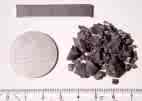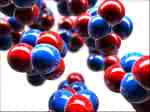BERYLLIUM
Home
Physical Characteristics
Sources of Beryllium
Industrial Uses
Health Hazards
Sampling and Analysis
Information Sources
Image Sources

Forms of Beryllium

Beryllium-Copper Alloy

Beryllium Model
BERYLLIUM |
||||
HomePhysical CharacteristicsSources of BerylliumIndustrial UsesHealth HazardsSampling and AnalysisInformation SourcesImage Sources
|
Forms of Beryllium |
Beryllium-Copper Alloy |
Beryllium Model |
|
Wipe Sampling |
||||
Wipes provide a method for sampling smooth surfaces that may be contaminated with beryllium. The analyst is typically at liberty to choose an appropriate size for the sampling area per wipe; square centimeters are a suitable frame of measurement. Options include dry wipe sampling and wet wipe sampling.Dry wipe sampling may be required for some surfaces that could be damaged or compromised by moisture or the specific compounds generally used to moisten the wipes. However, dry wipes remove only a fraction of the residue from a surface as wetted wipes do. If wetted wipes can be used without compromising the sampling surface, they are the preferred choice.Wet wipe sampling can be performed using wipes moistened with either distilled water or methanol. While both options remove a greater percentage of residues than dry wipe sampling, the methanol-wetted wipes have proven most efficient. However, the integrity of the sampling surface should again be taken into consideration when choosing the appropriate wetting agent.Analysis of Wipe
Samples: Two options are currently acceptable for analyzing beryllium
samples: Inductively Coupled Plasma Emission Spectroscopy (ICP-ES), and
Inductively Coupled Plasma Mass Spectroscopy (ICP-MS). ICP-ES is typically
more affordable and versatile than ICP-MS, which is why ICP-ES tends to
be the more popular analysis method. While interferences are possible
for both methods, ICP-MS is more susceptible to matrix interferences than
ICP-ES. However, ICP-MS provides the benefit of lower detection limits.
Analysts should consider what method is most appropriate for their needs
and facilities. |
||||